An H-Plane Groove Gap Waveguide Magic-T for X-Band Applications
Abstract
1. Introduction
2. Groove Gap Waveguide Design
3. T-Junctions Design
4. Magic-T Design
5. Magic-T Manufacturing and Test
6. Conclusions
Author Contributions
Funding
Institutional Review Board Statement
Informed Consent Statement
Data Availability Statement
Conflicts of Interest
References
- Pozar, D.M. Microwave Engineering, 4th ed.; John Wiley and Sons: Hoboken, NJ, USA, 2011. [Google Scholar]
- Chou, P.-J.; Lin, P.-C.; Lin, Y.-W.; Lu, J.-C.; Chang, C.-Y. Broadband planar magic-T with marchand type power divider and balun. In Proceedings of the 2014 Asia-Pacific Microwave Conference, Sendai, Japan, 4–7 November 2014; pp. 94–96. [Google Scholar]
- U-Yen, K.; Wollack, E.J.; Papapolymerou, J.; Laskar, J. A Broadband Planar Magic-T Using Microstrip–Slotline Transitions. IEEE Trans. Microw. Theory Tech. 2008, 56, 172–177. [Google Scholar] [CrossRef]
- Wang, Y.; Ma, K.; Mou, S. A Low-Loss Self-Packaged Magic-T With Compact Size Using SISL Technology. IEEE Microw. Wirel. Compon. Lett. 2018, 28, 13–15. [Google Scholar] [CrossRef]
- Mansouree, M.; Yahaghi, A. Planar Magic-Tee Using Substrate Integrated Waveguide Based on Mode-Conversion Technique. IEEE Microw. Wirel. Compon. Lett. 2016, 26, 307–309. [Google Scholar] [CrossRef]
- Zhu, F.; Hong, W.; Chen, J.-X.; Wu, K. Design and Implementation of a Broadband Substrate Integrated Waveguide Magic-T. IEEE Microw. Wirel. Compon. Lett. 2012, 22, 630–632. [Google Scholar] [CrossRef]
- Feng, W.; Che, W.; Deng, K. Compact Planar Magic-T Using E-Plane Substrate Integrated Waveguide (SIW) Power Divider and Slotline Transition. IEEE Microw. Wirel. Compon. Lett. 2010, 20, 331–333. [Google Scholar] [CrossRef]
- He, F.F.; Wu, K.; Hong, W.; Tang, H.J.; Zhu, H.B.; Chen, J.X. A Planar Magic-T Using Substrate Integrated Circuits Concept. IEEE Microw. Wirel. Compon. Lett. 2008, 18, 386–388. [Google Scholar] [CrossRef]
- Peng, W.; Xiao, Q.; Chen, X. K-Band Planar Magic-T Using LTCC Technology. IEEE Microw. Wirel. Compon. Lett. 2017, 27, 715–717. [Google Scholar] [CrossRef]
- Shen, T.-M.; Huang, T.-Y.; Chen, C.-F.; Wu, R.-B. A Laminated Waveguide Magic-T With Bandpass Filter Response in Multilayer LTCC. IEEE Trans. Microw. Theory Tech. 2011, 59, 584–592. [Google Scholar] [CrossRef]
- Guo, C.; Gao, Y.; Wang, Y.; Huang, G.-L.; Cheng, Q.S.; Zhang, A.; Li, J.; Yu, Y.; Zhang, F.; Zhu, Y.; et al. A 3-D Printed E-Plane Waveguide Magic-T Using Air-Filled Coax-to-Waveguide Transitions. IEEE Trans. Microw. Theory Tech. 2019, 67, 4984–4994. [Google Scholar] [CrossRef]
- Vincenti Gatti, R.; Rossi, R.; Dionigi, M.; Spigarelli, A. An X-band compact and low-profile waveguide magic-T. Int. J. RF Microw. Comput. Eng. 2019, 29, e21854. [Google Scholar] [CrossRef]
- Kumar, V.S.; Kurup, D.G. A New Broadband Magic Tee Design for Ka-Band Satellite Communications. IEEE Microw. Wirel. Compon. Lett. 2019, 29, 92–94. [Google Scholar] [CrossRef]
- He, Y.-J.; Mo, D.-Y.; Wu, Q.-S.; Chu, Q.-X. A Ka-Band Waveguide Magic-T With Coplanar Arms Using Ridge-Waveguide Transition. IEEE Microw. Wirel. Compon. Lett. 2017, 27, 965–967. [Google Scholar] [CrossRef]
- Guo, L.; Li, J.; Huang, W.; Shao, H.; Ba, T.; Jiang, T.; Jiang, Y.; Deng, G. A Waveguide Magic-T With Coplanar Arms for High-Power Solid-State Power Combining. IEEE Trans. Microw. Theory Tech. 2017, 65, 2942–2952. [Google Scholar] [CrossRef]
- Li, Y.; Zhang, Y.; Zhu, G.; Sun, Z.; Fan, Y. A w-band miniature power divider based on e-faced-folded magic-T junction. In Proceedings of the 2016 IEEE MTT-S International Microwave Workshop Series on Advanced Materials and Processes for RF and THz Applications (IMWS-AMP), Chengdu, China, 20–22 July 2016; pp. 1–3. [Google Scholar] [CrossRef]
- Wang, Y.; Dou, W.; Bi, B. W band axially displaced monopulse dual-reflector antenna for inter-satellite communications. IET Microw. Antennas Propag. 2016, 10, 742–747. [Google Scholar] [CrossRef]
- Gholami, M.; Amaya, R.E.; Yagoub, M.C. Low-loss compact power combiner for solid state power amplifiers with high reliability. IET Microw. Antennas Propag. 2016, 10, 310–317. [Google Scholar] [CrossRef]
- Huang, G.-L.; Zhou, S.-G.; Chio, T.-H.; Yeo, T.-S. Two types of waveguide comparator for wideband monopulse antenna array application. In Proceedings of the IEEE 5th Asia-Pacific Conference on Synthetic Aperture Radar (APSAR), Singapore, 1–4 September 2015; pp. 264–266. [Google Scholar] [CrossRef]
- Wang, L.; Shi, B. A method of design ka-band e-faced-folded compact waveguide magic-T junction. In Proceedings of the 3rd Asia-Pacific Conference on Antennas and Propagation, Harbin, China, 26–29 July 2014; pp. 1159–1161. [Google Scholar] [CrossRef]
- Chu, Q.-X.; Wu, Q.-S.; Mo, D.-Y. A Ka-Band E-Plane Waveguide Magic-T With Coplanar Arms. IEEE Trans. Microw. Theory Tech. 2014, 62, 2673–2679. [Google Scholar] [CrossRef]
- Leal-Sevillano, C.A.; Ruiz-Cruz, J.A.; Montejo-Garai, J.R.; Rebollar, J.M. Compact broadband couplers based on the waveguide magic-T junction. In Proceedings of the European Microwave Conference, Nuremberg, Germany, 6–10 October 2013; pp. 151–154. [Google Scholar] [CrossRef]
- Zhu, Z.; Dong, S.; Wang, Y.; Dong, Y. A design of k band e-plane folded magic tee matched in two ways for spatial power combining. In Proceedings of the International Conference on Electronics, Communications and Control (ICECC), Ningbo, China, 9–11 September 2011; pp. 4078–4081. [Google Scholar] [CrossRef]
- Hwang, K.C. Design and Optimization of a Broadband Waveguide Magic-T Using a Stepped Conducting Cone. IEEE Microw. Wirel. Compon. Lett. 2009, 19, 539–541. [Google Scholar] [CrossRef]
- Chen, Z.N.; Liu, D.; Nakano, H.; Qing, X.; Zwick, T. Handbook of Antenna Technologies; Springer: Singapore, 2016. [Google Scholar]
- Rajo-Iglesias, E.; Ferrando-Rocher, M.; Zaman, A.U. Gap Waveguide Technology for Millimeter-Wave Antenna Systems. IEEE Commun. Mag. 2018, 56, 14–20. [Google Scholar] [CrossRef]
- Nasri, M.; Zarifi, D. A broadband gap waveguide-based magic-T junction for millimeter-wave applications. Springer J. Infrared Milli. Terahz. Waves 2021, 42, 793–801. [Google Scholar] [CrossRef]
- Vosoogh, A.; Haddadi, A.; Zaman, A.U.; Yang, J.; Zirath, H.; Kishk, A.A. W-Band Low-Profile Monopulse Slot Array Antenna Based on Gap Waveguide Corporate-Feed Network. IEEE Trans. Antennas Propag. 2018, 66, 6997–7009. [Google Scholar] [CrossRef]
- Cheng, X.; Zhang, Q.; Yao, Y.; Wang, C.; Yu, T.; Yu, J.; Chen, X. W-Band Binary Phase-controlled Multibeam Antenna Array Based on Gap Waveguide Magic-Tee. IEEE Trans. Antennas Propag. 2022, 70, 1. [Google Scholar] [CrossRef]
- Farahbakhsh, A. Ka-Band Coplanar Magic-T Based on Gap Waveguide Technology. IEEE Microw. Wirel. Compon. Lett. 2020, 30, 853–856. [Google Scholar] [CrossRef]
- Khandani, A.K.; Farahbakhsh, A. Ka-band planar magic-T based on e-plane groove gap waveguide for monopulse antenna system. In Proceedings of the 14th European Conference on Antennas and Propagation (EuCAP), Copenhagen, Denmark, 15–20 March 2020; pp. 1–3. [Google Scholar] [CrossRef]
- Rajo-Iglesias, E.; Kildal, P.-S. Numerical studies of bandwidth of parallel-plate cut-off realised by a bed of nails, corrugations and mushroom-type electromagnetic bandgap for use in gap waveguides. IET Microw. Antennas Propag. 2011, 5, 282–289. [Google Scholar] [CrossRef]
- Kildal, P.-S.; Zaman, A.; Rajo-Iglesias, E.; Alfonso, E.; Valero-Nogueira, A. Design and experimental verification of ridge gap waveguide in bed of nails for parallel-plate mode suppression. IET Microw. Antennas Propag. 2011, 5, 262–270. [Google Scholar] [CrossRef]
- Raza, H.; Yang, J.; Kildal, P.; Alfonso, E. Resemblance between gap waveguides and hollow waveguides. IET Microw. Antennas Propag. 2013, 7, 1221–1227. [Google Scholar] [CrossRef]
- Rossi, R.; Vincenti Gatti, R. X-Band In-Line Coaxial-to-Groove Gap Waveguide Transition. Electronics 2022, 11, 2361. [Google Scholar] [CrossRef]
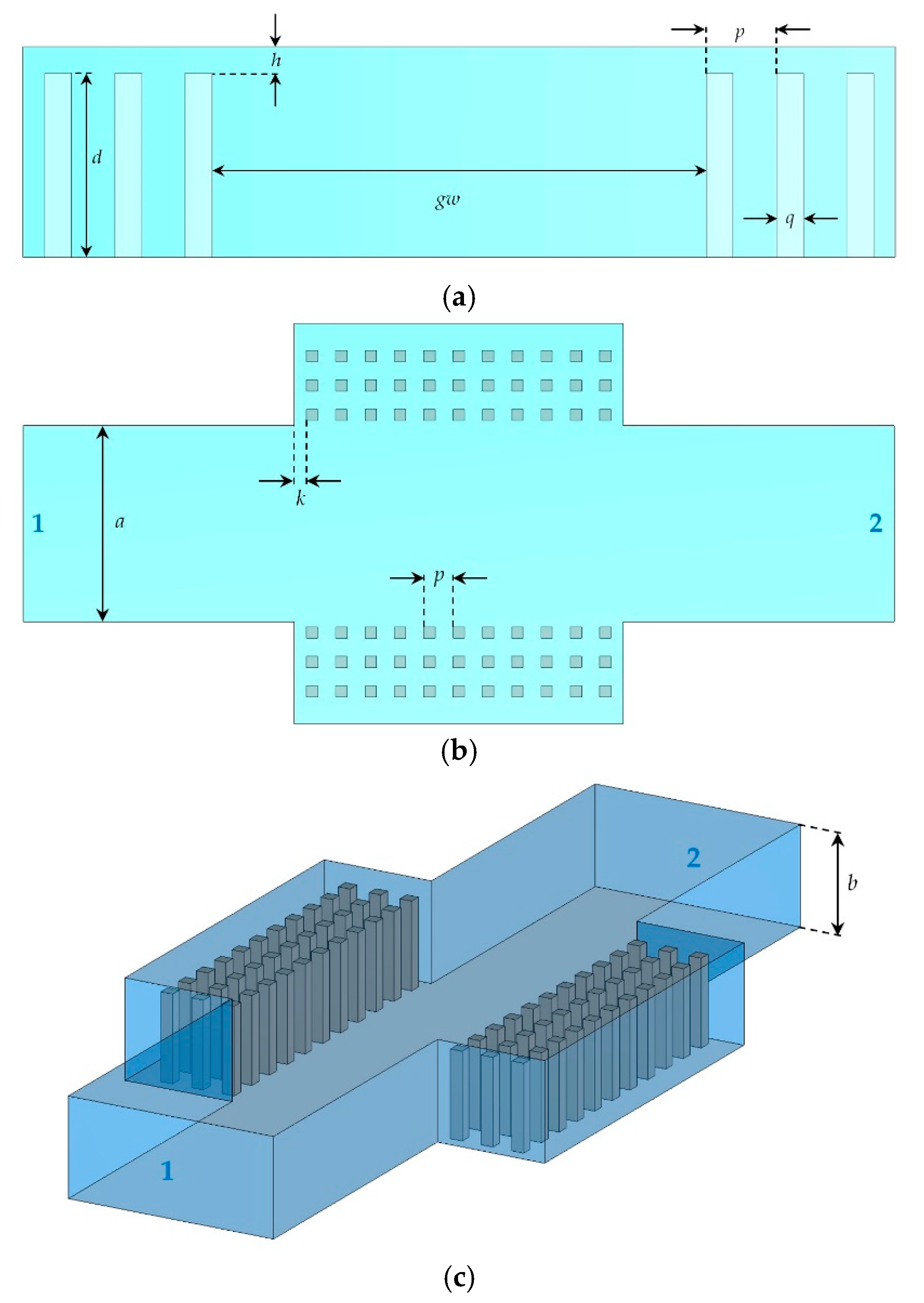




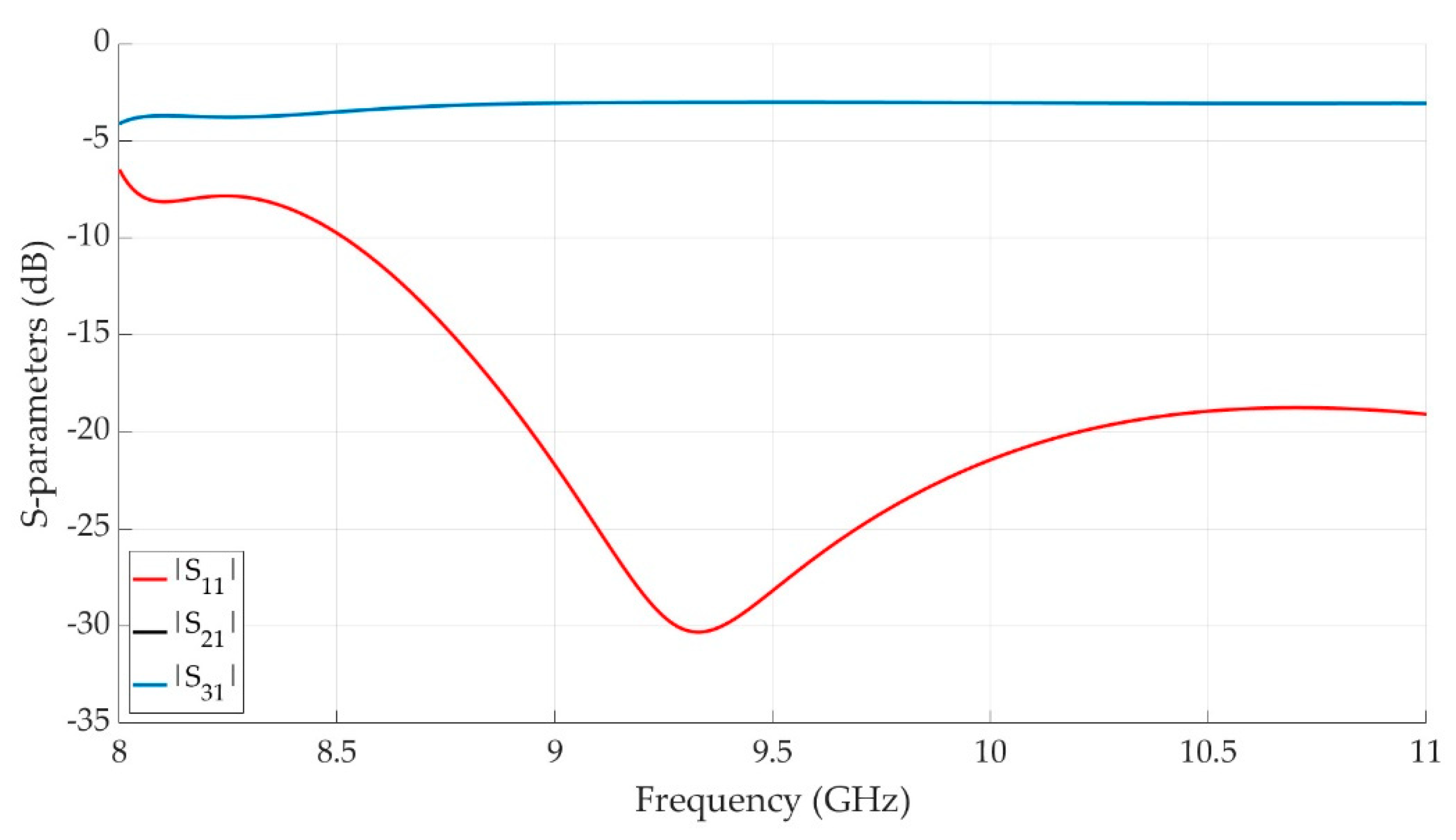

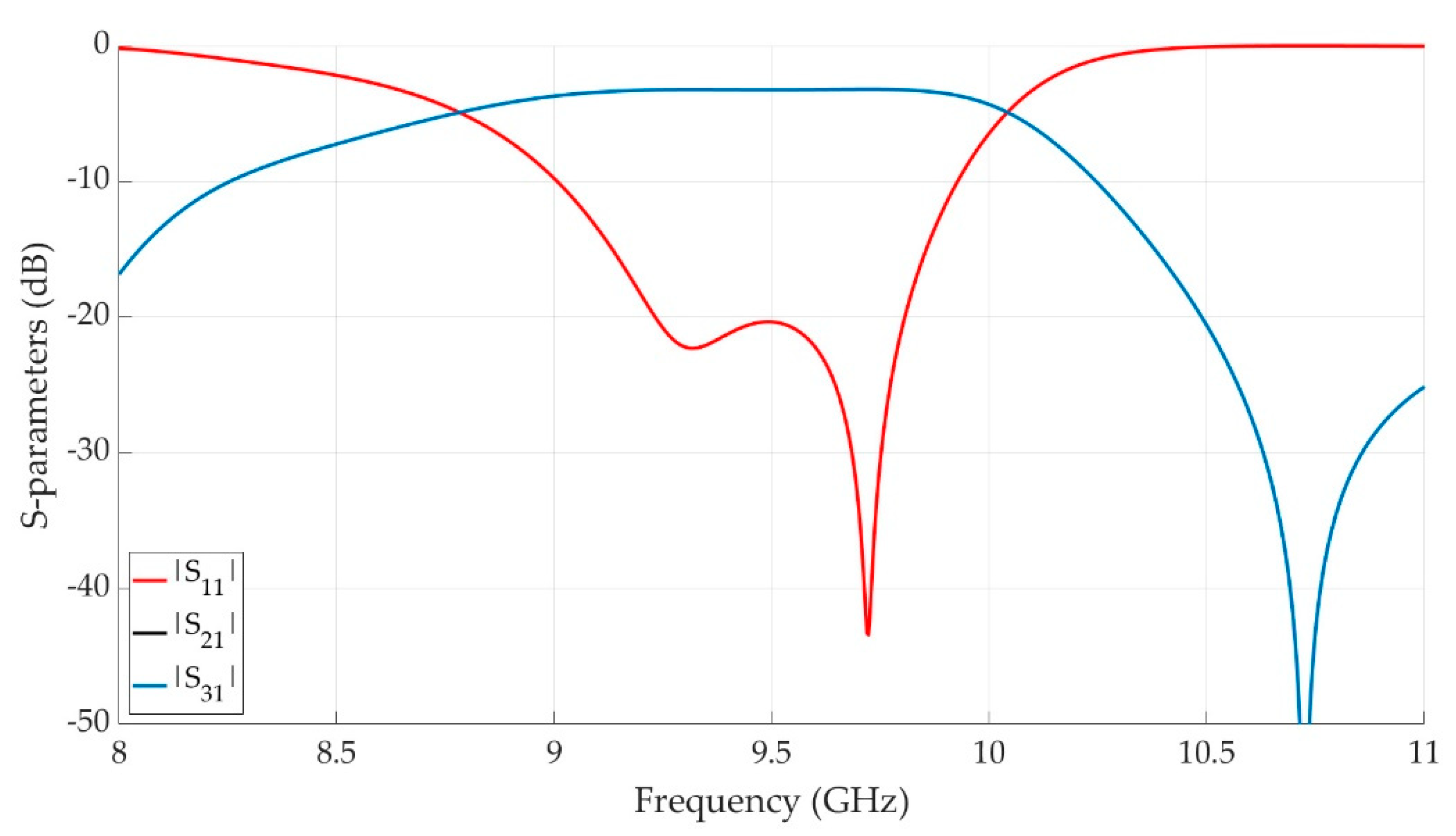
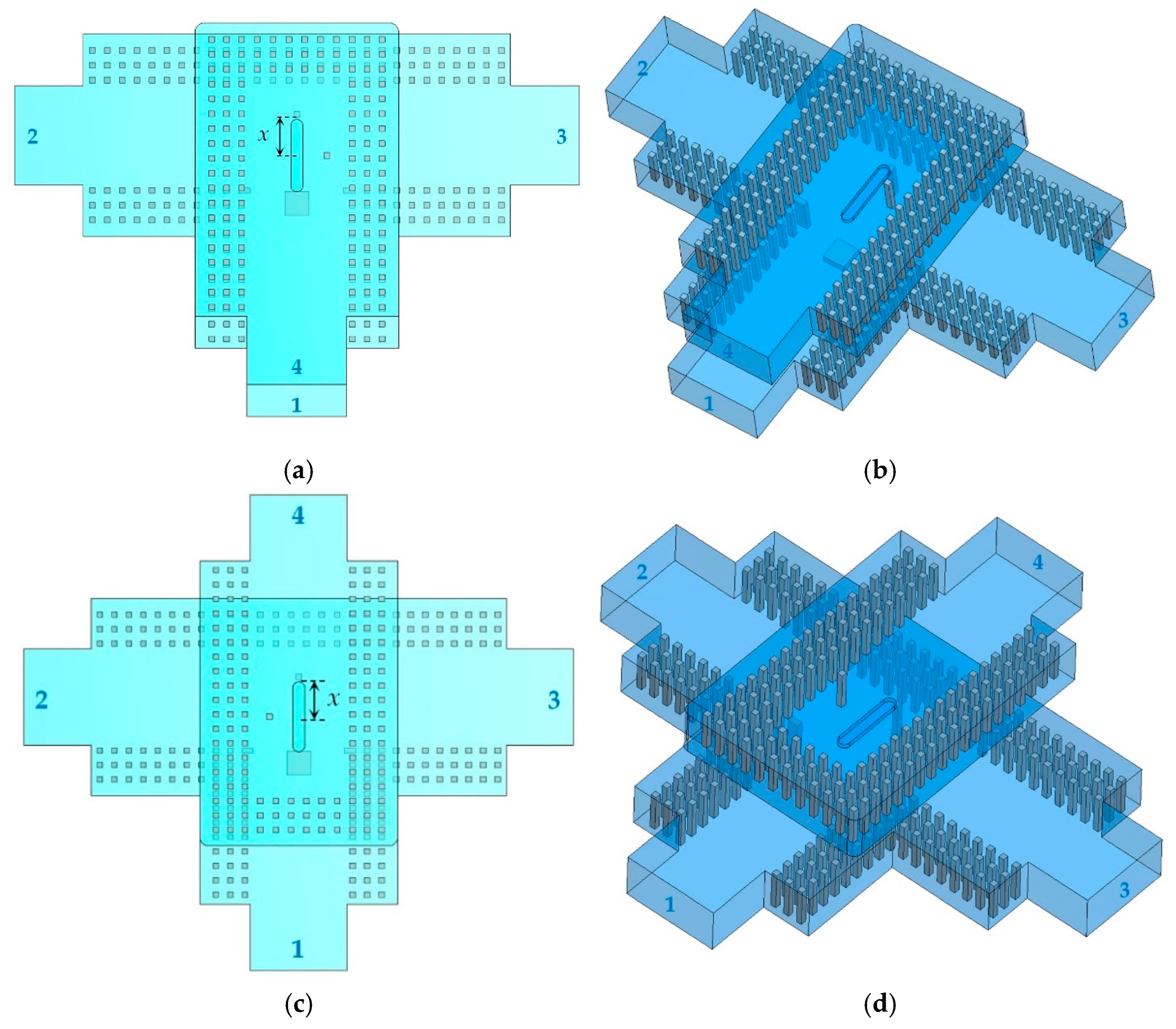

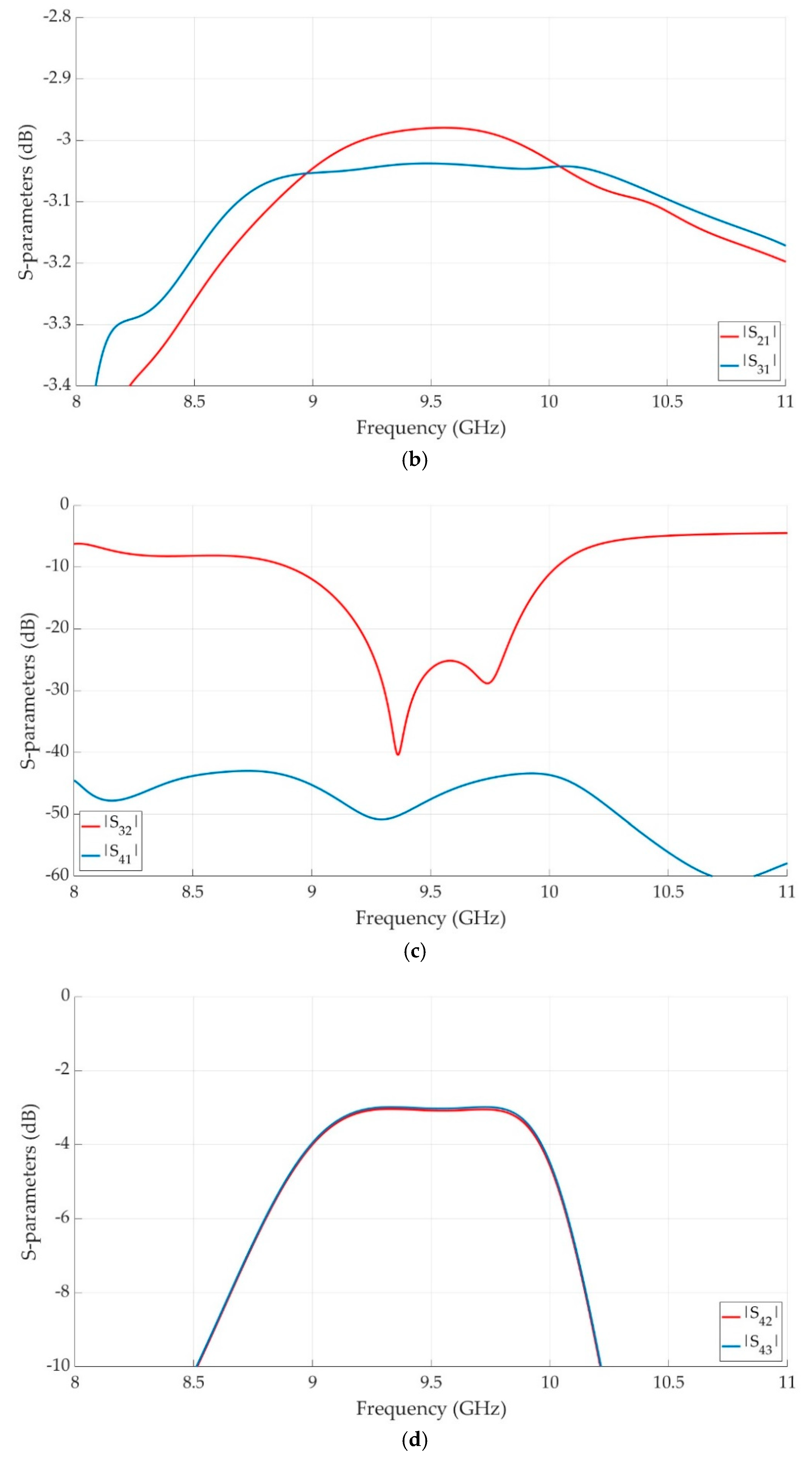
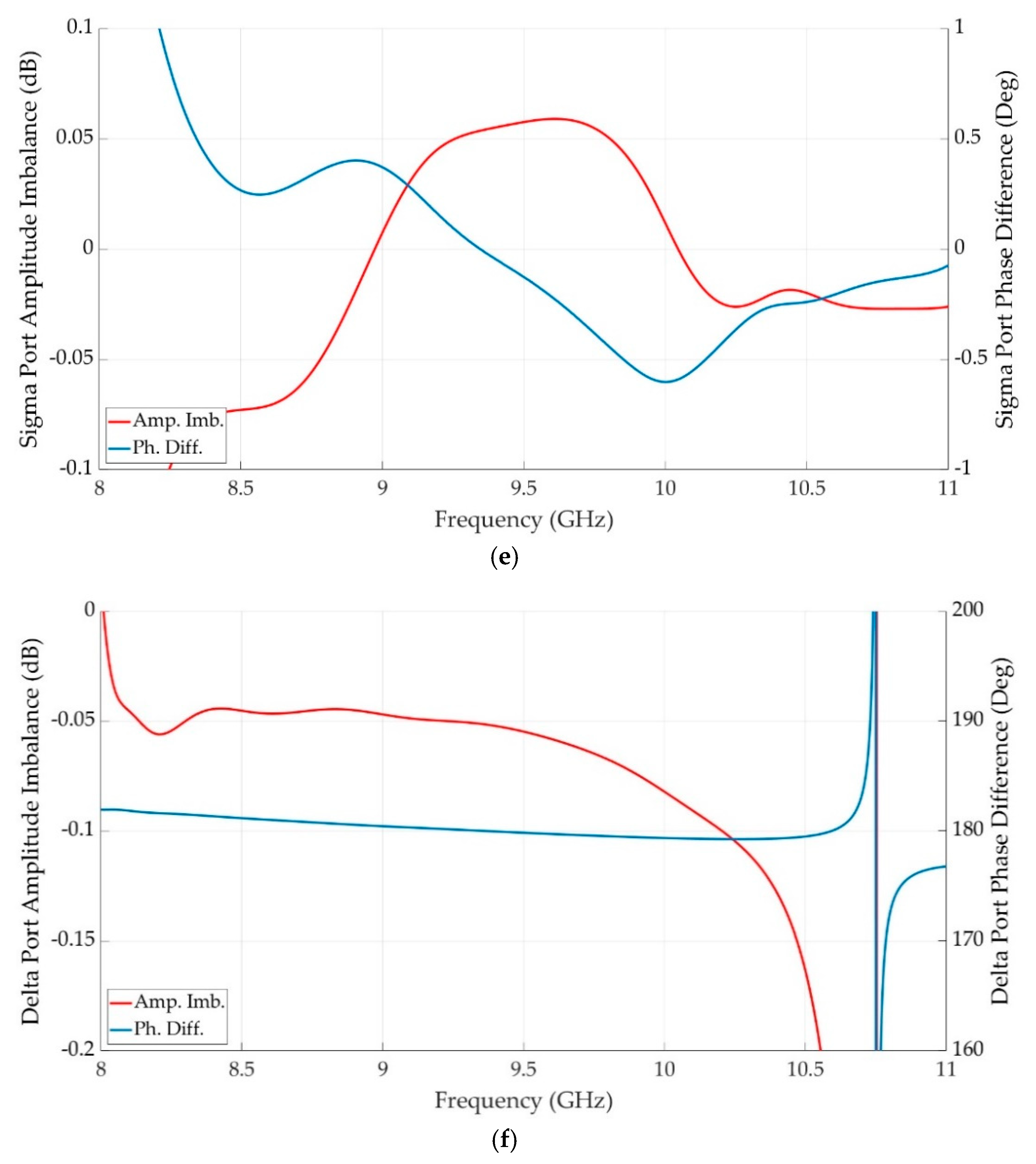


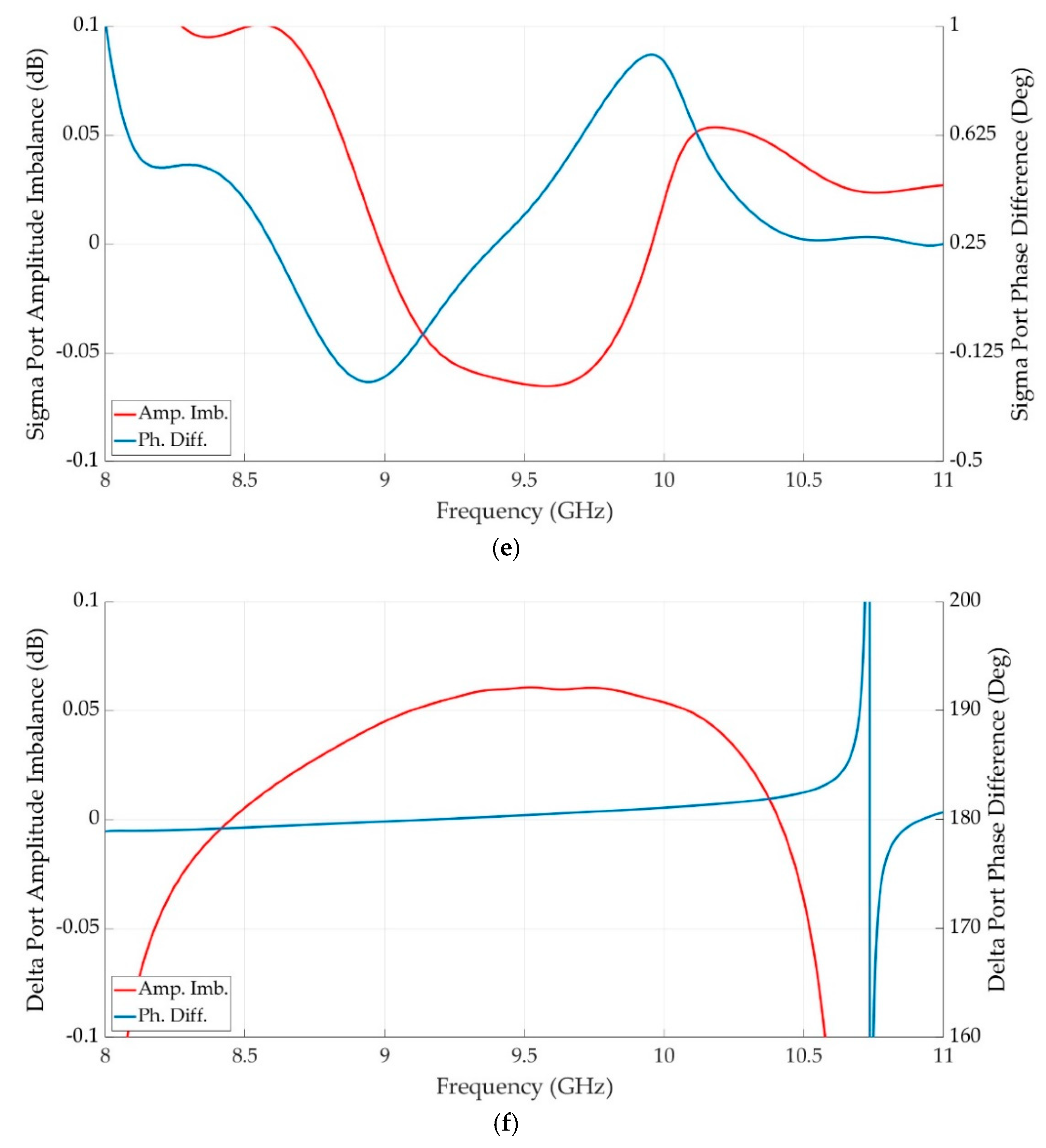
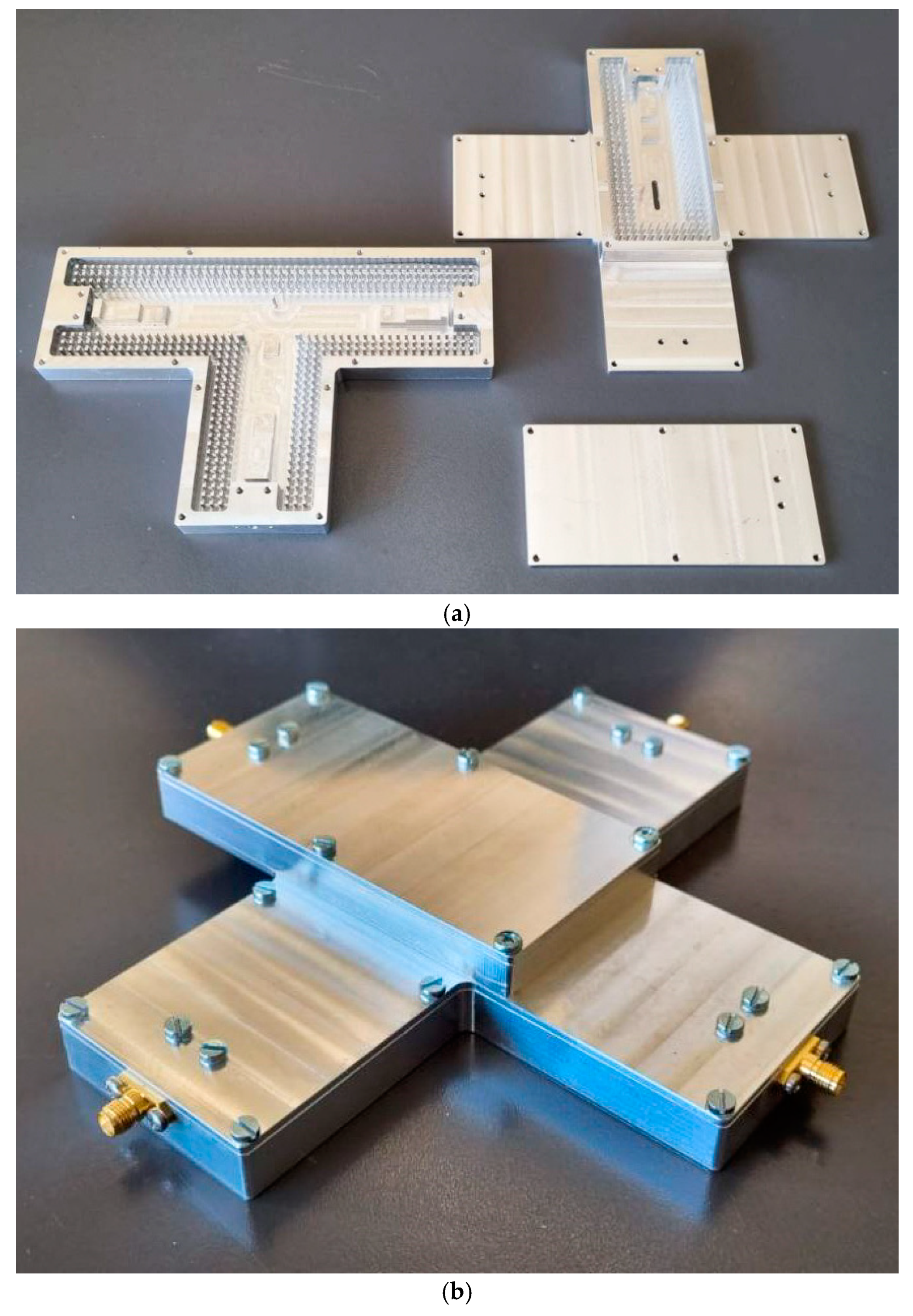


| Parameter | Description | Value (mm) |
|---|---|---|
| a | Eq. waveguide width | 21.70 |
| b | Eq. waveguide height | 10.00 |
| d | Pin height | 8.75 |
| gw | Groove width | 22.86 |
| h | Air gap separation | 1.25 |
| k | Eq. waveguide distance | 1.37 |
| p | Pin pitch | 3.25 |
| q | Pin side | 1.25 |
| Parameter | Description | Value (mm) |
|---|---|---|
| bh | Block height | 0.50 |
| bl | Block length | 4.38 |
| bx | Block offset | 4.92 |
| il | Iris length | 2.86 |
| p1l | Post 1 length | 9.01 |
| Parameter | Description | Value (mm) |
|---|---|---|
| d | Short distance | 18.35 |
| p2l | Post 2 length | 5.50 |
| sl | Slot length | 16.34 |
| sw | Slot width | 3.85 |
| t | Slot thickness | 1.00 |
| Parameter | Description | TMT Value (mm) | XMT Value (mm) |
|---|---|---|---|
| bh | Block height | 1.77 | 1.80 |
| bl | Block length | 5.24 | 5.31 |
| bx | Block offset | 3.45 | 3.38 |
| d | Short distance | 18.27 | 18.32 |
| il | Iris length | 2.53 | 2.43 |
| p1l | Post 1 length | 7.48 | 7.44 |
| p2l | Post 2 length | 5.52 | 5.51 |
| sl | Slot length | 15.79 | 15.74 |
| sw | Slot width | 2.62 | 2.63 |
| t | Slot thickness | 1.00 | 1.00 |
| x | Slot offset | 8.40 | 8.42 |
Publisher’s Note: MDPI stays neutral with regard to jurisdictional claims in published maps and institutional affiliations. |
© 2022 by the authors. Licensee MDPI, Basel, Switzerland. This article is an open access article distributed under the terms and conditions of the Creative Commons Attribution (CC BY) license (https://creativecommons.org/licenses/by/4.0/).
Share and Cite
Rossi, R.; Vincenti Gatti, R. An H-Plane Groove Gap Waveguide Magic-T for X-Band Applications. Electronics 2022, 11, 4075. https://doi.org/10.3390/electronics11244075
Rossi R, Vincenti Gatti R. An H-Plane Groove Gap Waveguide Magic-T for X-Band Applications. Electronics. 2022; 11(24):4075. https://doi.org/10.3390/electronics11244075
Chicago/Turabian StyleRossi, Riccardo, and Roberto Vincenti Gatti. 2022. "An H-Plane Groove Gap Waveguide Magic-T for X-Band Applications" Electronics 11, no. 24: 4075. https://doi.org/10.3390/electronics11244075
APA StyleRossi, R., & Vincenti Gatti, R. (2022). An H-Plane Groove Gap Waveguide Magic-T for X-Band Applications. Electronics, 11(24), 4075. https://doi.org/10.3390/electronics11244075







